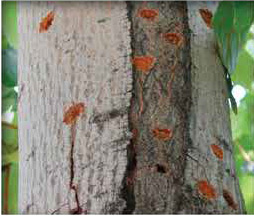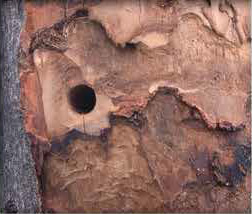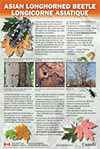
The Asian longhorned beetle (ALHB) is a highly destructive wood-boring pest of maples and other hardwood trees including poplar, birch and willow. ALHB infests and kills healthy trees, devastating rural, urban and suburban communities.
Simulated signs of infestation, which show what an actual ALHB infestation may look like, have been created on this tree. Two specific signs of infestation have been used to show the typical damage caused by the ALHB in the environment (Figures 1, 2).
ALHB is native to Asia and spreads through transport of infested wood products including firewood and logs.
You can help protect your community from this invasive insect:
- check trees for evidence of ALHB
- collect possible ALHB specimens if found
- to report possible ALHB or ALHB tree damage visit plant pests and invasive species
- don't move firewood
Other signs and symptoms of this pest include:
- sawdust and wood shavings (frass)
- galleries and tunnels under the bark
- foamy or frothy sap running from egg laying sites
- thinning crowns/dead branches
- cracked or missing bark
- tree death
Figure 1

Figure 2

Figure 3

